View in other NatureServe Network Field Guides
NatureServe
Montana
Utah
Wyoming
Idaho
Wisconsin
British Columbia
South Carolina
Yukon
California
New York
Edith's Checkerspot - Euphydryas editha
General Description
[From Ferris and Brown 1981; Scott 1986; Glassberg 2001, Pyle 2002] Forearm 1.3-2.1 cm. Most easily separated by the processes of the male genetalia, one clubbed the other tapered, making great than 90 degree angle with respect to each other. Forewing usually rounded, abdomen without white off-center (subdorsal) spots, lower half of antennae clubs with much black; dorsal surface a combination of red, black, and cream bands and checkers; ventral surface of forewing with postmedian cream spot along lower edge with heavier black scaling on basal (inner) side, hindwing postmedian orange band often extends into median cream band; pale ventral hindwing median band sometimes narrow so that black line outward of band separates two reddish areas (bands).
Phenology
One flight; March and April on the California coast, June in the Great Basin, late June to early August above treeline (Scott 1986); May to early August in the Rocky Mountains (Ferris and Brown 1981); early April to late August in Oregon and Washington (Pyle 2002).
Diagnostic Characteristics
Best separated by the processes of the male genitalia, one clubbed the other tapered, making great than 90 degree angle with respect to each other. Also useful are a combination of forewing usually rounded, abdomen without white off-center (subdorsal) spots, lower half of antennae clubs with much black, ventral surface of forewing with postmedian cream spot along lower edge with heavier black scaling on basal (inner) side.
Species Range
Montana Range
Range Descriptions
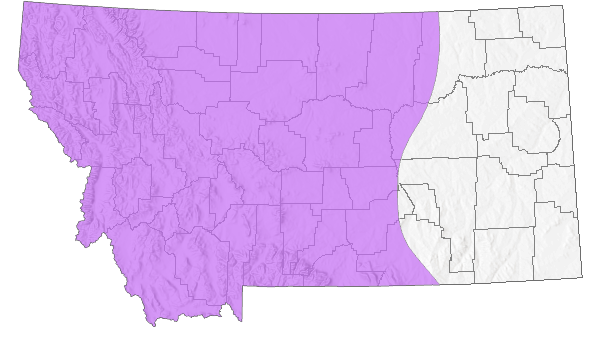
 Native
Native
Range Comments
West of the Great Plains, from southern British Columbia and the Rocky Mountains of Alberta south to northern Baja California, southern Utah, and southern Colorado (Scott 1986; Glassberg 2001). In Montana, reported from the western two-thirds of the state (Kohler 1980, Stanford and Opler 1993). Generally locally rare to uncommon, common at high elevations in the Sierra Nevada of California (Glassberg 2001).
Observations in Montana Natural Heritage Program Database
Number of Observations: 24
(Click on the following maps and charts to see full sized version)
Map Help and Descriptions
Relative Density
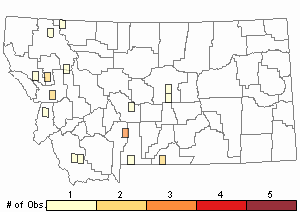
Recency
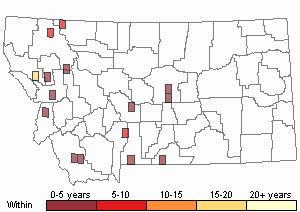
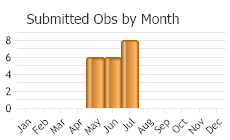
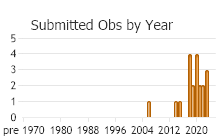
 (Observations spanning multiple months or years are excluded from time charts)
(Observations spanning multiple months or years are excluded from time charts)
Migration
Non-migratory. Adults may move up to 10 km, but average movements to about 200 m (Scott 1986).
Habitat
Chaparral, coastal prairie, sagebrush steppe, high ridges, open woodlands and montane meadows, above treeline in alpine tundra and fellfield (Ehrlich and Wheye 1984; Scott 1986; Pyle 2002; James and Nunnallee 2011); to at least 2440 m elevation in Oregon and Washington, to 3300 m elevation in Colorado, Wyoming and Montana. In Montana, reported from above treeline in the Beartooth Mountains and Glacier National Park, and many other localities where the habitat not described (Kohler 1980; Hendricks 1986; Debinski 1993).
Food Habits
Larval food plants include Castilleja, Collinsia, Lonicera, Mimulus, Orthocarpos, Pedicularis, Penstemon, Plantago, Plectritis, and Valerianella. Adults feed on flower nectar (including Achillea, Agoseris, Allium, Erigeron, Eriodictyon, Erioganum, Lesquerella, Lomatium, Mimulus, Pseudocymopterus, Senecio, Taraxacum, Wyethia) (Ferris and Brown 1981; Ehrlich and Wheye 1984; Scott 1986, 2014; Guppy and Shepard 2001; Pyle 2002; James and Nunnallee 2011).
Reproductive Characteristics
Females lay eggs in clusters of 20-350, up to 1200 eggs in a lifetime. Number of eggs per ovariole (1/8 of total) about 170 (Ehrlich and Ehrlich 1978). Eggs laid on the undersides of host leaves or flower inflorescences. Eggs hatch in about 8-9 days (depending on temperature). Larvae live in loose silk webs during the first three instars (L1-L3). Development from L1-L4 takes about 30 days; L3 and L4 instars hibernate (diapause), often under stones or curled leaves. After diapause is broken, L4 reach L5 in about 14 days, pupating a few days later (Scott 1986; James and Nunnallee 2011). Males seeking females patrol and perch throughout the day on ridge crests and hilltops, sometimes perch on shrubs (Scott 1975b, 1986); adults live about 7 days on average.
Stewardship Responsibility
References
- Literature Cited AboveLegend:
 View Online Publication
View Online Publication Debinski, D. 1993. Butterflies of Glacier National Park, Montana. Occasional Papers of the Museum of Natural History, the University of Kansas, Lawrence, Kansas. No. 159: 1-13.
Debinski, D. 1993. Butterflies of Glacier National Park, Montana. Occasional Papers of the Museum of Natural History, the University of Kansas, Lawrence, Kansas. No. 159: 1-13. Ehrlich, A.H. and P.R. Ehrlich. 1978. Reproductive strategies in the butterflies: I. Mating frequency, plugging, and egg number. Journal of the Kansas Entomological Society 51(4): 666-697.
Ehrlich, A.H. and P.R. Ehrlich. 1978. Reproductive strategies in the butterflies: I. Mating frequency, plugging, and egg number. Journal of the Kansas Entomological Society 51(4): 666-697. Ehrlich, P.R. and D. Wheye. 1984. Some observations on spatial distribution in a montane population of Euphydryas editha. Journal of Research on the Lepidoptera 23(2): 143-152.
Ehrlich, P.R. and D. Wheye. 1984. Some observations on spatial distribution in a montane population of Euphydryas editha. Journal of Research on the Lepidoptera 23(2): 143-152. Ferris, C.D. and F.M. Brown (eds). 1981. Butterflies of the Rocky Mountains. Univ. of Oklahoma Press. Norman. 442 pp.
Ferris, C.D. and F.M. Brown (eds). 1981. Butterflies of the Rocky Mountains. Univ. of Oklahoma Press. Norman. 442 pp. Glassberg, J. 2001. Butterflies through Binoculars: A Field Guide to the Butterflies of Western North America. Oxford University Press.
Glassberg, J. 2001. Butterflies through Binoculars: A Field Guide to the Butterflies of Western North America. Oxford University Press. Guppy, C.S. and J.H. Shepard. 2001. Butterflies of British Columbia: including western Alberta, southern Yukon, the Alaska Panhandle, Washington, northern Oregon, northern Idaho, northwestern Montana. UBC Press (Vancouver, BC) and Royal British Columbia Museum (Victoria, BC). 414 pp.
Guppy, C.S. and J.H. Shepard. 2001. Butterflies of British Columbia: including western Alberta, southern Yukon, the Alaska Panhandle, Washington, northern Oregon, northern Idaho, northwestern Montana. UBC Press (Vancouver, BC) and Royal British Columbia Museum (Victoria, BC). 414 pp. Hendricks, P. 1986. Avian predation of alpine butterflies. Journal of the Lepidopterists' Society 40(2): 129.
Hendricks, P. 1986. Avian predation of alpine butterflies. Journal of the Lepidopterists' Society 40(2): 129. James, D.G. and D. Nunnallee. 2011. Life histories of Cascadia butterflies. Corvallis, OR: Oregon State University Press. 447 p.
James, D.G. and D. Nunnallee. 2011. Life histories of Cascadia butterflies. Corvallis, OR: Oregon State University Press. 447 p. Kohler, S. 1980. Checklist of Montana Butterflies (Rhopalocera). Journal of the Lepidopterists' Society 34(1): 1-19.
Kohler, S. 1980. Checklist of Montana Butterflies (Rhopalocera). Journal of the Lepidopterists' Society 34(1): 1-19. Pyle, R.M. 2002. The butterflies of Cascadia: a field guide to all the species of Washington, Oregon, and surrounding territories. Seattle Audubon Society, Seattle, Washington. 420 pp.
Pyle, R.M. 2002. The butterflies of Cascadia: a field guide to all the species of Washington, Oregon, and surrounding territories. Seattle Audubon Society, Seattle, Washington. 420 pp. Scott, J.A. 1975b. Mate-locating behavior of western North American butterflies. Journal of Research on the Lepidoptera 14:1-40.
Scott, J.A. 1975b. Mate-locating behavior of western North American butterflies. Journal of Research on the Lepidoptera 14:1-40. Scott, J.A. 1986. The butterflies of North America: a natural history and field guide. Stanford University Press, Stanford, California.
Scott, J.A. 1986. The butterflies of North America: a natural history and field guide. Stanford University Press, Stanford, California. Scott, J.A. 2014. Lepidoptera of North America 13. Flower visitation by Colorado butterflies (40,615 records) with a review of the literature on pollination of Colorado plants and butterfly attraction (Lepidoptera: Hersperioidea and Papilionoidea). Contributions of the C.P. Gillette Museum of Arthopod Diversity. Fort Collins, CO: Colorado State University. 190 p.
Scott, J.A. 2014. Lepidoptera of North America 13. Flower visitation by Colorado butterflies (40,615 records) with a review of the literature on pollination of Colorado plants and butterfly attraction (Lepidoptera: Hersperioidea and Papilionoidea). Contributions of the C.P. Gillette Museum of Arthopod Diversity. Fort Collins, CO: Colorado State University. 190 p. Stanford, R.E. and P.A. Opler. 1993. Atlas of western USA butterflies: including adjacent parts of Canada and Mexico. Unpubl. Report. Denver and Fort Collins, Colorado 275 pp.
Stanford, R.E. and P.A. Opler. 1993. Atlas of western USA butterflies: including adjacent parts of Canada and Mexico. Unpubl. Report. Denver and Fort Collins, Colorado 275 pp.
- Additional ReferencesLegend:
 View Online Publication
View Online Publication
Do you know of a citation we're missing? Allen, T.J., J.P. Brock, and J. Glassberg. 2005. Caterpillars in the field and garden: a field guide to the butterfly caterpillars of North America. Oxford University Press.
Allen, T.J., J.P. Brock, and J. Glassberg. 2005. Caterpillars in the field and garden: a field guide to the butterfly caterpillars of North America. Oxford University Press. Brock, J.P. and K. Kaufman. 2003. Kaufman Field Guide to Butterflies of North America. Houghton Mifflin Company, New York, NY 284 pp.
Brock, J.P. and K. Kaufman. 2003. Kaufman Field Guide to Butterflies of North America. Houghton Mifflin Company, New York, NY 284 pp. Caruthers, J.C., and D. Debinski. 2006. Montane meadow butterfly species distributions in the Greater Yellowstone Ecosystem. University of Wyoming National Park Service Research Center Annual Report, 2006. Vol. 30, Art. 14. 85-96.
Caruthers, J.C., and D. Debinski. 2006. Montane meadow butterfly species distributions in the Greater Yellowstone Ecosystem. University of Wyoming National Park Service Research Center Annual Report, 2006. Vol. 30, Art. 14. 85-96. Debinski, D. M. 1991. Inventory and monitoring of biodiversity: an assessment of methods and a case study of Glacier National Park, MT. Ph.D. Dissertation. Montana State University, Bozeman. 205 p.
Debinski, D. M. 1991. Inventory and monitoring of biodiversity: an assessment of methods and a case study of Glacier National Park, MT. Ph.D. Dissertation. Montana State University, Bozeman. 205 p. Debinski, D.M. and J.A. Pritchard. 2002. A field guide to the butterflies of the Greater Yellowstone Ecosystem. Lanham, MD: Roberts Rinehart Publishers. 107 p.
Debinski, D.M. and J.A. Pritchard. 2002. A field guide to the butterflies of the Greater Yellowstone Ecosystem. Lanham, MD: Roberts Rinehart Publishers. 107 p. Forister, M.L., C.A. Halsch, C.C. Nice, J.A. Fordyce, T.E. Dilts, J.C. Oliver, K.L. Prudic, A.M. Shapiro, J.K. Wilson, J. Glassberg. 2021. Fewer butterflies seen by community scientists across the warming and drying landscapes of the American West. Science 371:1042-1045.
Forister, M.L., C.A. Halsch, C.C. Nice, J.A. Fordyce, T.E. Dilts, J.C. Oliver, K.L. Prudic, A.M. Shapiro, J.K. Wilson, J. Glassberg. 2021. Fewer butterflies seen by community scientists across the warming and drying landscapes of the American West. Science 371:1042-1045. Forister, M.L., E.M. Grames, C.A. Halsch, K.J. Burls, C.F. Carroll, K.L. Bell, J.P. Jahner, et al. 2023. Assessing risk for butterflies in the context of climate change, demographic uncertainty, and heterogeneous data sources. Ecological Monographs 93(3):e1584. https://doi.org/10.1002/ecm.1584
Forister, M.L., E.M. Grames, C.A. Halsch, K.J. Burls, C.F. Carroll, K.L. Bell, J.P. Jahner, et al. 2023. Assessing risk for butterflies in the context of climate change, demographic uncertainty, and heterogeneous data sources. Ecological Monographs 93(3):e1584. https://doi.org/10.1002/ecm.1584 Layberry, R.A., P.W. Hall, and J.D. LaFontaine. 1998. The Butterflies of Canada. University of Toronto Press. 280 pp. + color plates.
Layberry, R.A., P.W. Hall, and J.D. LaFontaine. 1998. The Butterflies of Canada. University of Toronto Press. 280 pp. + color plates. Scott, J.A. 1992. Hostplant records for butterflies and skippers (mostly from Colorado) 1959-1992, with new life histories and notes on oviposition, immatures, and ecology. Papilio new series #6. 185 p.
Scott, J.A. 1992. Hostplant records for butterflies and skippers (mostly from Colorado) 1959-1992, with new life histories and notes on oviposition, immatures, and ecology. Papilio new series #6. 185 p. Simanonok, M.P., and L.A. Burkle. 2014. Partitioning interaction turnover among alpine pollination networks: Spatial temporal, and environmental patterns. Ecosphere 5(11):149.
Simanonok, M.P., and L.A. Burkle. 2014. Partitioning interaction turnover among alpine pollination networks: Spatial temporal, and environmental patterns. Ecosphere 5(11):149.
- Web Search Engines for Articles on "Edith's Checkerspot"
- Additional Sources of Information Related to "Insects"





